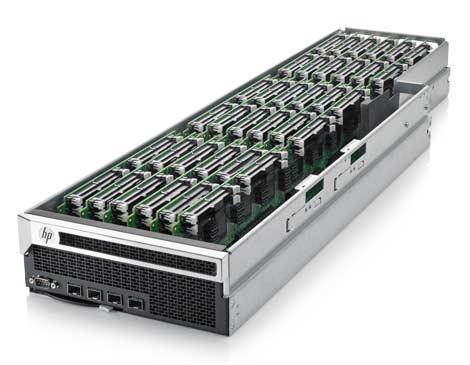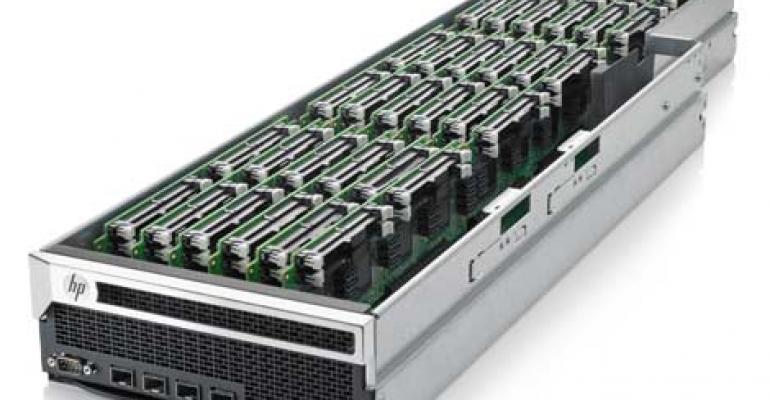
An HP Redstone Development Platform server, using ARM chip technology from Calxeda.
When HP first announced its Project Moonshot server initiative in November, 2011, the announcement centered on the potential for low-power ARM chips from Calxeda to be the agent of transformation. Yesterday HP began selling its first production servers ... based on Intel Atom chips.
As HP touted its new servers as game changers, Calxeda is again talking about how its ARM technology is still ... well, the future. The company today reaffirmed its "ongoing commitment" to Project Moonshot, saying HP servers based on Calxeda technology will be in production "later this year."
"We were honored to be selected by HP to be among the very first Project Moonshot partners at the November 1, 2011 launch and to have our processors incorporated into HP’s first generation of extreme low energy servers," said Calxeda CEO, Barry Evans. "Since that time, the two companies have worked closely to advance extreme low-energy processing technologies, which have received positive industry response, and outstanding early customer implementations."
HP says Moonshot consists of a "comprehensive roadmap" of workload-optimized ProLiant servers that will incorporate processors from partners including AMD, AppliedMicro, Cavium and Texas Instruments, as well as Calxeda and Intel. This approach is part of HP's focus on flexibility, offering customers more options for processors and faster iteration of server designs.
With Moonshot, HP is providing an architecture that adapts some of the concepts of blade chassis, centralizing components like power supplies and fans at the chassis level, with hot-swappable server cards that can be used to customize compute processing with particular workloads. This ability to match different processors to specific workloads is one of the most interesting features. And that's where Calxeda and the other chip vendors come in.
Calxeda says that once its Moonshot server arrives, it will offer better TCO than the Intel Atom Centerton based products unveiled today. The server will feature four ECX-1000 servers, running at 1.4 Ghz, each with 4 GB DRAM.
But by the time Calxeda's Moonshot server is ready for production, Intel may be moving the goalposts again. In the second half of 2013, Moonshot servers will begin using the next generation of Intel's Atom chips, known as Avoton. Intel says Avoton will quadruple the densityof the current prodiuct with 4 Avoton SoCs per server. Avoton is built on Intel’s 3D tri-gate 22-nanometer process technology and is based on a new microarchitecture codenamed “Silvermont.”
"We have not only enabled the first Moonshot system to lift-off, but with Avoton we will also bring HP Moonshot’s customers a revolution in energy efficiency and performance per watt to drive major TCO improvements when processing lightweight web scale workloads," writes Intel's Raejeanne Skillern in a blog post.
Will Moonshot reverse a trend in which the largest server purchasers have been working with original design manufacturers (ODMs) or next-generation designs from the Open Compute Project? It remains to be seen, but the progress of Moonshot will give data center operators initial options to manage the energy being used in their facilities. A key question is whether HP's focus on converged infrastructure - standardized around HP hardware, software and services - will gain traction in the fast-moving landscape for web-scale servers.





